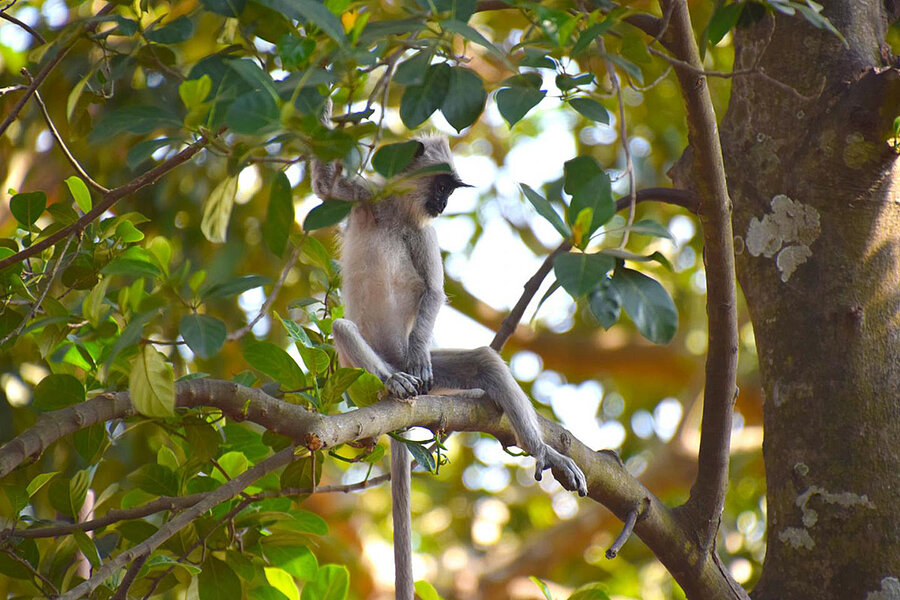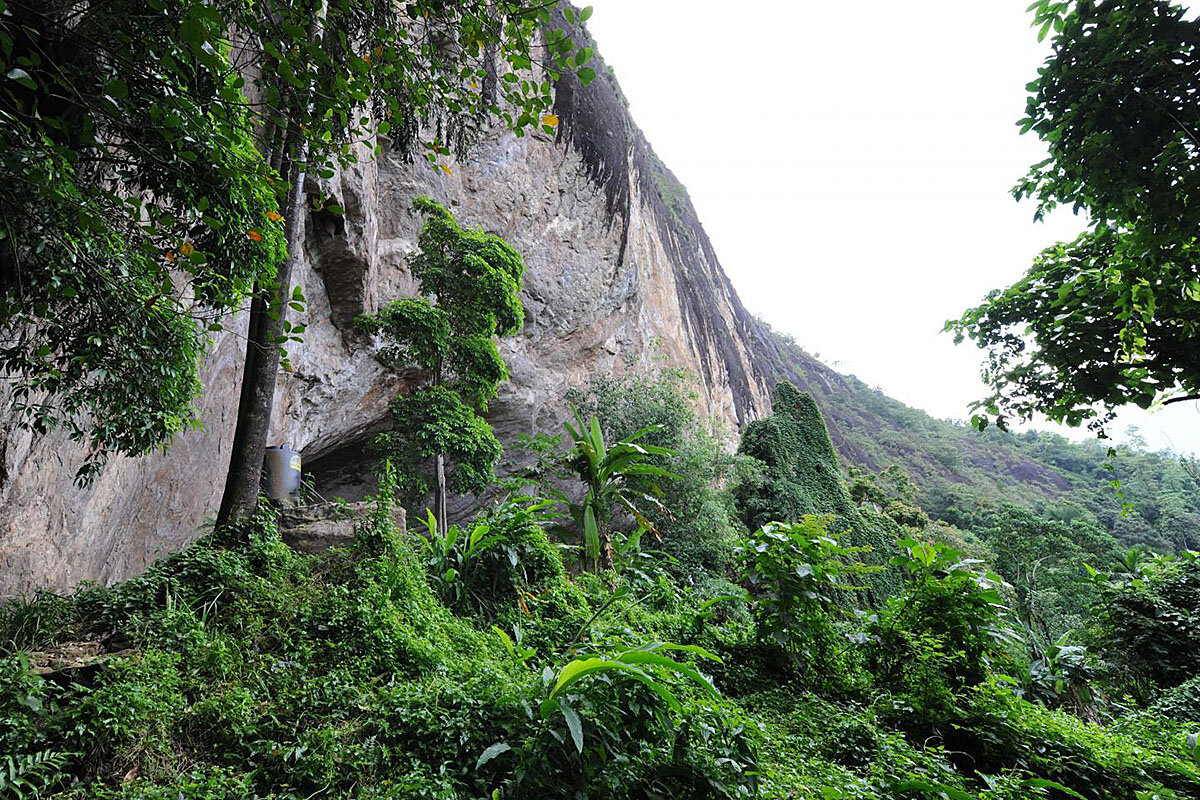Early humans conquered the Sri Lankan rainforest – one meal at a time
Loading...
You are what you eat.
That’s what parents tell their children to get them to eat their vegetables. But there might be another side to the story. Humans’ eating habits may have helped lay the groundwork for our rule of the planet, setting us apart from all other animal species.
Homo sapiens have walked on almost every inch of dry land on Earth, from the frigid Arctic Circle to dense tropical forests to extremely high elevations. That makes us unique in the animal kingdom. As far as we know, no other species has ever colonized the globe as extensively as H. sapiens – not even other human species, such as the extinct Neanderthals and Homo erectus.
Why We Wrote This
New research bolsters the idea that early peoples' ability to see opportunity in any environment helped them to thrive in seemingly inhospitable terrain.
So how did we do it? Scientists have been pondering that question for decades. Many now think that our species’ ability to adapt to diverse, extreme environments may have been key. And surviving in a new place means finding something to eat.
The latest piece of the puzzle comes from a tropical rainforest in Sri Lanka. Researchers examining archaeological artifacts there found evidence that, starting around 45,000 years ago, people predominantly ate small arboreal and semiarboreal mammals like monkeys and giant squirrels. Furthermore, they made specialized tools from the animal bones to hunt them. The scientists reported their findings in a paper published Tuesday in the journal Nature Communications.
Why does that diet matter?
“These small animals are very hard to catch, and they don’t have much meat on them,” explains study coauthor Patrick Roberts, an archaeologist at the Max Planck Institute for the Science of Human History in Jena, Germany. Previously, some scientists thought these small mammals were just an emergency food source.
“What’s quite interesting in our study is that we don’t have evidence for that,” he says. “This is actually occurring as humans colonize the rainforest in this part of the world and continues all the way from the beginning of this period right through to around 3,000 years ago, at least.” Furthermore, isotope analysis of human teeth found at the site suggests these people’s diet was chiefly rainforest derived, so they weren’t venturing out of the trees for much sustenance.
“This adds to an impressive body of evidence,” says Peter Ungar, a paleoanthropologist and director of the environmental dynamics program at the University of Arkansas, “that shows us just how versatile a species we are, not just today, but into the distant past as well.”
Exploiting resources with a new intensity
Ian Tattersall, a paleoanthropologist and a curator emeritus at the American Museum of Natural History, says it’s not surprising to find that H. sapiens were exploiting the environment in Sri Lanka at that time with that level of sophistication, because these were fully anatomically modern humans. “People were already people,” he says.
But, Dr. Tattersall adds, H. sapiens were not the only humans to be flexible eaters. “Dietary generalism goes back right to the beginning of the hominid family,” he says. When the earliest members of the genus Homo were expanding into new environments across Africa, he explains, they were exploiting a much wider variety of food resources than their ape relatives. “What changed with H. sapiens was the way in which they did this, was the intensity with which they were able to exploit the environment.”
Dr. Roberts thinks that plays out as our species occupying a unique ecological niche. Animals typically are either generalists – able to eat pretty much anything and survive in any environment, such as raccoons – or specialists. Giant pandas, for example, live only in humid bamboo forests on mountains in China, chowing down only on bamboo.
But H. sapiens, Roberts argues, are “generalists-specialists.” Our species can acclimate to pretty much any environment. And once we’re in it, we can develop tools and adaptations specifically to exploit the resources available there. For example, in the Sri Lankan rainforest, those early human populations made bone tools specially designed to hunt monkeys and squirrels, the abundant resource there.
Meal planning and abstract thought
So how did we come to be such versatile and skilled eaters? Climate change, Roberts says.
Human evolution occurred during dramatic and rapid climatic fluctuations during the last ice age. In fact, many scientists think that’s what drove our speciation. And in Roberts’s generalist-specialist model, that’s why H. sapiens are so adaptable and why our species now reigns: because we evolved under those seesawing conditions.
Dr. Ungar agrees. “I think our success as a species is probably due in part to the fact that we could find something to eat on all of this planet’s myriad biosphere buffet tables,” he says. Whether that capability is a result of evolving under such conditions or simply how H. sapiens survived them remains an open question.
But other members of the genus Homo – like Neanderthals – were around during that climatic time, too. So why aren’t they, too, living all over the globe?
Tattersall asserts that there’s something unique about the way modern humans think.
What makes H. sapiens different, he says, is the “ability to deconstruct the environment into a vocabulary of mental symbols that can then be moved around to create new visions of the world.”
This capacity for abstract thought, Tattersall argues, enables members of our species to plan ahead, to carefully consider how to interact with the environment, and to develop complex technologies to do so. Other species, he says, simply respond to stimuli.
In this hypothesis, it’s not what we eat or where we are; it’s how we relate to food and our environment more generally that sets H. sapiens apart from other species. Tattersall expands on this view in his upcoming book, “The Accidental Homo Sapiens,” which he co-wrote with Rob DeSalle.
But finding evidence of cognitive capabilities in the fossil record isn’t straightforward, says Roberts. And, he adds, it’s a question of which came first: Did a symbolic cognition allow for humans to colonize diverse environments, or did the process of doing so develop such a way of thinking?
What he can say, though, is that the early Sri Lankans didn’t plunder their food resources. The fossil record suggests that the populations of those small mammal meals remained stable up until about 4,000 years ago. And that suggests a recognition of ecosystem dynamics, and perhaps even a conscious effort to conserve the resource.







